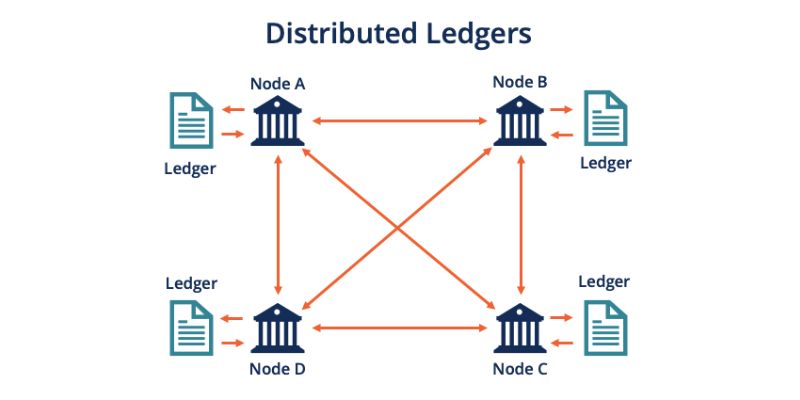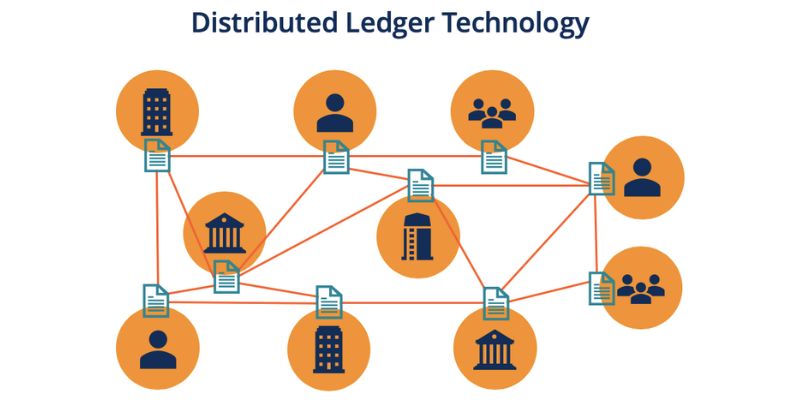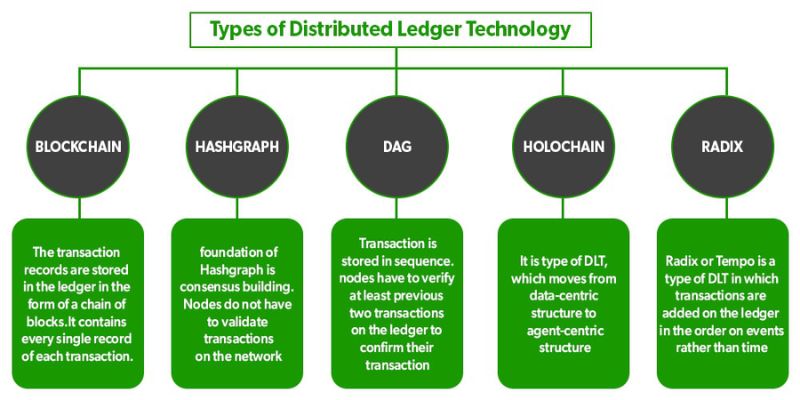Distributed Ledger Demystified: Unlocking the Tech Revolution
Have you ever asked yourself, What is a distributed ledger? If so, you’re not alone. This tech is changing how we keep records and trust data. Imagine a book that writes itself, updates no matter where you are, and never lies. That’s the heart of distributed ledger technology (DLT). It’s a new way of recording info and doing business, making sure everything is fair and square. No more need for a middleman checking and saying what’s what. Let me take you by the hand and show you the ABCs of DLT and why it matters in our digital world.
Understanding the Basics of Distributed Ledger Technology
Defining Distributed Ledger Technology and How It Works
Let’s dig into distributed ledger technology, or DLT. You can think of it like a shared notebook. But instead of paper, it’s digital and copies exist across a network. Everyone can see all notes made in this notebook, making it hard for someone to cheat. Each page in the notebook is a “block” of data. These blocks link up in order, forming a “chain” – that’s blockchain for you!
So, what happens if someone wants to add a note? Here’s the cool part – the rest of the group checks it first. They make sure it matches the notebook rules. Only then can the note join the party. This checking work is a big deal. It’s called “consensus” and helps keep everyone honest. This process makes sure all copies of the notebook match up. No one person is in charge. It’s a team effort, and that’s a game changer.
Core Principles and Characteristics of Distributed Ledgers
Now let’s talk about what makes DLT tick. Think of it as a tree with deep roots. These roots are principles and traits that hold strong no matter what.
First up is the “decentralized” bit. This means no single person or place has control. Data spreads out across many spots. They all talk to each other, staying up-to-date.
Next, we have “transparency.” Imagine a glass house; you can see everything that goes on inside. That’s how DLT works. Every change is there for all to see.
We also can’t forget “security.” DLT is like a fortress with high walls. It’s tough for hackers to break in. This security comes from complex math – “cryptography.” It locks away data so only the right people can look at it.
And how about making changes? That’s “immutability” for you. Once you write something down, it’s set in stone. You can’t just erase it. This helps folks trust the system because you can’t fiddle with the history.
“Scalability” is another star player. This means the system can grow. Think of a town expanding into a bustling city. The more people join, the more the system adjusts to stay smooth and fast.
Last but not least, there are “public” and “private” ledgers. A public ledger is an open book – all are welcome. A private one is more like an invite-only club. Only members get to peek inside.
So, why bother with all this DLT business? Well, it can change how we do things, big time. From keeping track of money in banks to making sure a watch is the real deal. It’s even shaking up how we vote! DLT lets us share info that’s accurate, safe, and clear. We can trust it because it’s built on these solid principles. And that, my friends, is a small peek into the world of distributed ledgers.
Distributed Ledgers vs. Traditional Systems
How DLT Differs from Centralized Databases
I want to talk about how distributed ledger tech (or DLT) stands out from the old way of storing info. Think of a ledger like a list. In the past, this list was kept in one place, like a bank’s computer. That’s a centralized database. But DLT is different. Instead of one list in one place, we have copies of this list on many computers. Each copy updates as things change. Everyone sees the same thing!
This means something neat for security. If someone tries to cheat or mess up one list, the others won’t match. They’ll say, “That’s not right!” This keeps our records honest and safe. Besides, without a single point of control, it’s tough for a bad guy to hurt the system.
The Advantages and Limitations of Using DLT in Various Sectors
DLT is more than just safe; it’s also super handy in many places. Financial services adore DLT for quick and honest money transfers. This saves time and cash. But it’s not just about cash. Supply chains use it to track goods, from fresh apples to the latest tech. It stops fakes and speeds up shipping.
For folks who need record keeping, like in health or law, DLT keeps things crystal clear. No more mix-ups over who owns what or what was agreed on. That’s the power of DLT. In energy, it lets people buy and sell power like never before. And in places where trust is vital, like voting, DLT can help ensure that every vote is counted just once, fair and square.
Still, DLT is not perfect. It needs a lot of juice to run, and not all computers can keep up. Sometimes a DLT can get too slow if too many people use it at once. Plus, it’s still new, and not all laws fit it just right. Some people worry about who can see their info on these shared ledgers, too.
In closing, DLT has a lot to offer, from making stuff safer to shaking up whole industries. Yet, it’s still growing and finding its place in our world. We’ve got to balance its perks with the things it needs to work on. That’s the deal with DLT – it’s our shiny, new tool that we’re still learning to use just right!
The Building Blocks of a Distributed Ledger
Exploring Different Types of Distributed Ledgers and Consensus Mechanisms
Let’s dive into the world of distributed ledgers, shall we? Think of a ledger as a record book. But instead of one book, imagine many copies. Each copy is in a different place, yet they all have the same data. That’s a distributed ledger for you! It’s not stored in one spot. No single person has control over it. This makes it tough to mess with. What’s more? Everyone using it helps keep it up to date.
Now, you may wonder, “How do these ledgers agree on the updates?” That’s where consensus mechanisms come in. They are the rules that everyone follows to update the ledger. There are many kinds, like Proof of Work or Proof of Stake. Each has its way to make sure the updates are fair.
For example, with Proof of Work, users solve puzzles to add new entries. In Proof of Stake, those with more of the cryptocurrency can add entries. It’s like a game where each player helps write the rule book.
The Role of Smart Contracts and dApps in Enhancing DLT Functionality
Imagine you want to feed your pet while away. You could use a smart device. You load it with food and set a timer. When the time comes, it feeds your pet without you being there. Smart contracts work much like that. They run by themselves when conditions are met, no human needed.
These smart contracts live on distributed ledgers. They help make deals, share property, and more. It’s all automatic and follows the code. Think of a vending machine. You put money in, and it gives you a snack. No store cashier needed! That’s smart contracts. They cut out the middleman. This can save time and lower the chance of mistakes or cheating.
Now, what if we build whole programs on top of these smart contracts? Welcome to decentralized applications, or dApps. They work just like other apps we use. The big difference is they run on a distributed network, not a single computer. This can make them more open and secure. Imagine a social media app that no single company controls. This means no one can shut it down or control your data.
DLT is changing how we think about trust and cooperation on the internet. As we build more on this tech, who knows what cool stuff we can create next?
Real-World Applications and Future of Distributed Ledgers
Key Use Cases Across Industries: From Finance to Supply Chain
Imagine a world where you can track a tomato from the farm to your plate. Or a place where sending money across the globe takes seconds, not days. This world is not far-off; it’s here thanks to distributed ledger technology (DLT).
In finance, DLT lets us send money fast and cheap. No more waiting or high fees. Banks use it to cut costs and make transactions smoother. Insurance firms use it to handle claims better. They all like DLT because it’s safe and works non-stop.
Now, let’s talk supply chains. With DLT, every step a product takes is recorded. This means you can see where your stuff comes from. It stops fakes and even keeps food safe. Companies can spot problems faster and fix them.
The Evolving Landscape of DLT: Challenges, Regulatory Aspects, and Innovations
But DLT isn’t perfect yet. It faces some tough problems. The biggest? Making sure it can handle lots of users at once, also known as scalability. Another hard nut to crack is working with different DLT systems. We call this interoperability.
Rules and laws for DLT also keep changing. New rules can make DLT safer for everyone. But sometimes, they can also slow things down. We need to find a balance to keep the DLT world growing.
Innovations keep coming up too. DLT now has smart contracts. These are like regular contracts but run by computers. They can self-execute and self-enforce rules set in the contract. This cuts down the need for middlemen. Decentralized apps (dApps) also run on DLT. They give power to the users and take it away from one boss.
Looking ahead, DLT is set to change even more industries. It could help verify who you are online, track who votes, or manage power grids. It’s not just about money; it’s about trusting the system to be fair and open.
We’ve just scratched the surface. The future of DLT is bright, and it’s forging paths into parts of our lives we never thought possible. So stay tuned, the tech revolution is just getting started.
In this post, we broke down the nuts and bolts of distributed ledger technology. We started by defining DLT and how it works, then dug into its key principles. We also compared DLT to old-school, centralized systems, laying out pros and cons for different industries.
Next, we unpacked the key parts that make up a distributed ledger. We looked at various types and ways to reach agreement, and how smart contracts and dApps boost DLT’s powers.
Finally, we zoomed in on real-world uses of DLT, from money to keeping track of stuff, and peeked at what’s next. We explored how DLT is changing, the bumps it faces, and the new ideas coming up.
Bottom line: DLT is game-changing, but it’s no magic fix-all. It’s exciting stuff, though, and I’m all eyes and ears for what comes next. Keep watching this space because DLT’s journey is just starting, and its map is still being drawn.
Q&A :
What is the concept of a distributed ledger?
A distributed ledger is a consensus of replicated, shared, and synchronized digital data geographically spread across multiple sites, countries, or institutions. Unlike traditional ledgers that are maintained by a central authority, distributed ledgers have no central data store or administration functionality. In a distributed ledger, each node in the network processes and verifies every item, thereby generating a record of each item and creating a consensus on each item’s veracity.
How does a distributed ledger differ from a traditional ledger?
The key difference between a distributed ledger and a traditional ledger lies in control and accessibility. Traditional ledgers are centralized, meaning they are controlled and maintained by a single entity, which could be a bank, a company, or a government agency. On the other hand, distributed ledgers are decentralized with no central authority overseeing the data. They enable multiple participants to maintain their own identical copy of the ledger, and any changes or transactions are reflected in all copies in minutes or seconds.
What are the benefits of using a distributed ledger?
The benefits of using a distributed ledger technology include enhanced security, improved transparency, and increased efficiency. Security is achieved through the use of cryptographic techniques and decentralized storage, making it difficult for unauthorized changes to be made to the records. Transparency comes from the fact that all transactions are visible to all participants in the network, making it easy to track and verify transactions. Increased efficiency is gained by eliminating the need for intermediaries, thereby reducing transaction times and costs.
Can distributed ledgers be used for applications other than cryptocurrencies?
Yes, distributed ledgers can be used for a wide range of applications beyond cryptocurrencies. These include supply chain management, identity verification, voting systems, real estate processing, and more. The ability to securely and transparently track the movement of goods, the identity of individuals, or the casting and counting of votes, makes distributed ledger technology a promising solution for many industries looking to solve complex problems related to trust and traceability.
What are the challenges associated with implementing a distributed ledger?
Implementing a distributed ledger poses several challenges. One of the primary concerns is scalability since each transaction must be propagated throughout the network, which can take time and resources. Ensuring privacy is another issue, as the transparency of the ledger makes it difficult to conceal sensitive data. Furthermore, integrating with existing systems can be complex and may require significant investment in technology and skill development. Lastly, regulatory and legal concerns need to be addressed as the technology disrupts traditional business processes and models.


